 |
A trap on a serene day Postmarked 1925. |
FISH TRAPS
"In the last few decades of the 1800s, many salmon canneries were being built in a tri-county area consisting of Whatcom, San Juan, and Skagit. By 1900 we had two of the largest salmon canneries in the world. These were Pacific American Fisheries (PAF), the largest located in Fairhaven, and Alaska Packers Association (APA) located in Blaine.  |
P.A.F. Cannery Fairhaven, Whatcom County, WA. from the archives of the Saltwater People Historical Society.© |
 |
P.A.F. painting crew.
There was a job for everyone
as the author writes in the last paragraph.
Photo from the archives of
the Saltwater People Historical Society©
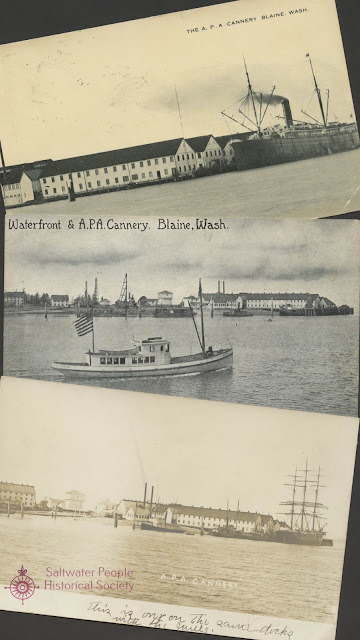 |
Alaska Packers Assoc. Blaine, Whatcom County, WA. Click image to enlarge. From the archives of the S.P.H.S.© |
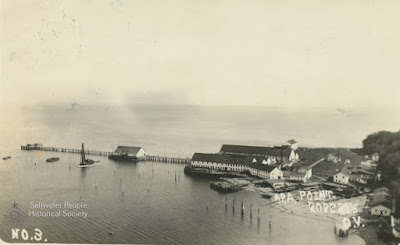 |
A.P.A. Point Roberts, Whatcom County, WA. The pile driver is in view, left of center. Click image to enlarge. Photo from the archives of the Saltwater People Historical Society© |
 |
Apex, Sanitary Fish, FIC Canneries lined the waterfront of Fidalgo Island, Skagit County, WA. |
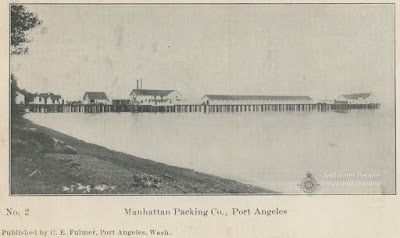 |
Manhattan Packing, On the other side of the Straits in Port Angeles, Clallam County, WA. Litho photo from the archives of the S.P.H.S.© |
In order to supply these canneries a large number of salmon needed to be caught. The salmon certainly were available in large numbers. The solution was the use of salmon traps, commonly known as fish traps. Most of the traps were owned by the canneries, but there were a few independent owners. The traps were very efficient; the salmon in most cases came into the traps in large numbers. All the canneries had to do was take the fish out of the traps and into the cannery to be processed. The traps did, however, need a lot of material and equipment to put them in and take them out.
 |
Trap fishers at work Click image to enlarge |
The traps consisted of four parts: the lead, heart, pot, and the spiller. The lead was a line of piles driven about ten to fifteen feet apart in a straight line across the tidal stream that carried the salmon. On this line of piling, the wire was attached from high water to the bottom. These leads were designed to lead salmon into deeper water and into the heart. By law, they were limited to 2,500 feet in length. The heart was web hung on piling and led the salmon to a funnel-shaped tunnel about ten feet on the outside, to a much smaller one on the inside.
This tunnel led into the pot where the salmon couldn’t find their way out. The pot was a huge bag hung on pilings about forty feet by forty feet and deep enough to hold up to 70,000 salmon. It was made out of heavy-duty cotton web heavily tarred. By law, the pot could not be over 65’ at low water. From the pot, the salmon were turned into the spiller, a bag much like the pot but smaller. It had a large apron-style brailer that was used to roll the salmon onto scows. The power for this brailer came from the trap tender. The men it took to brail the salmon usually came with tender or sometimes they stayed on the beach in shacks. Eight to ten men were needed. The trap tenders were more like tugs and usually had small fish holds because most of the fish went into scows for transport to the canneries.
This tunnel led into the pot where the salmon couldn’t find their way out. The pot was a huge bag hung on pilings about forty feet by forty feet and deep enough to hold up to 70,000 salmon. It was made out of heavy-duty cotton web heavily tarred. By law, the pot could not be over 65’ at low water. From the pot, the salmon were turned into the spiller, a bag much like the pot but smaller. It had a large apron-style brailer that was used to roll the salmon onto scows. The power for this brailer came from the trap tender. The men it took to brail the salmon usually came with tender or sometimes they stayed on the beach in shacks. Eight to ten men were needed. The trap tenders were more like tugs and usually had small fish holds because most of the fish went into scows for transport to the canneries.
Tender and scow |
Returning with salmon,
calm water, and a big crew.
Click image to enlarge.
Low res scan from an original photo
from the archives of
the Saltwater People Historical Society.©
The equipment used to install the traps in the spring and take them out in the fall was extensive and expensive. They needed pile drivers, pile pullers, rigging, scows, web yards, sheds, and of course, tugboats and scows. The pile drivers used were usually with 80’ gins and three-ton drop hammers. They were all steam-powered. The high gins were needed because many of the piles they drove were very long. To drive in 65 feet you need a pile sometimes 100’ depending on penetration. Many of the pile drivers had sleeping and eating accommodations aboard, all the comforts of home along with bedbugs and other cooties.
Once the pilings were in, the rigging scow took over to hang the wire and web. The pile pullers were only needed in the fall to extract all the piles driven and to store them. Many were stored along the outside beaches at San Juan Park, at Jakle’s Lagoon and also in Mitchell Bay. They were still there two decades after 1934. Friday Harbor Packing Co had a web house and a web yard on what is now called Web St. Here they tossed the web and built parts they needed to build the traps and to store them during the offseason.
Once the pilings were in, the rigging scow took over to hang the wire and web. The pile pullers were only needed in the fall to extract all the piles driven and to store them. Many were stored along the outside beaches at San Juan Park, at Jakle’s Lagoon and also in Mitchell Bay. They were still there two decades after 1934. Friday Harbor Packing Co had a web house and a web yard on what is now called Web St. Here they tossed the web and built parts they needed to build the traps and to store them during the offseason.
 |
"Fish traps on the west side of San Juan Island" San Juan Archipelago, WA. As inscribed verso. Photographer unknown. Photo from the archives of the Saltwater People Historical Society© |
The most important thing to have a successful salmon trap was its location. They needed to be placed where large numbers of salmon passed by and where it was possible to build the traps. They needed shallow water shorelines that dropped off gradually. Shorelines that dropped sharply in water 65’ were out of the question. It so happened that the Salmon Bank at the southeast end of San Juan Island was ideal. The bank runs one and one-half nautical miles south to a navigational buoy, from there it curves back towards shore, but at the same time continues westward to Eagle Point.
Friday Harbor Packing had traps in this area along with the giants mentioned earlier, PAF and APA and others as well. There was a trap west of Eagle Point at False Bay. This trap belonged to independent operator Henry Cayou. This trap was a big producer of King salmon. Henry had a Salish mother and had that I ate understanding of the characteristics and movement of salmon. This made him a great fisherman. He was also a wise businessman and an all-around fine gentleman. He had other traps in other locations as well.
One further up Haro Strait at Deadman’s Bay, and another one at Mitchell Bay owned by Cayou and Haroldson. There was also a trap at Battleship Island that was put in by an Anacortes outfit, probably Lowman’s Coastal Fish Co. The tidal currents were so strong there it was very difficult to install or to keep in place. It was a big disappointment because it mostly caught Humpbacks. The canneries at that time didn’t keep this species. Next in line was a trap at John’s Island, owner unknown to this writer. There were many more traps in the area, too many to list here. The traps mentioned were typical of them all and were close to home for the people living on San Juan Is.
Friday Harbor Packing had traps in this area along with the giants mentioned earlier, PAF and APA and others as well. There was a trap west of Eagle Point at False Bay. This trap belonged to independent operator Henry Cayou. This trap was a big producer of King salmon. Henry had a Salish mother and had that I ate understanding of the characteristics and movement of salmon. This made him a great fisherman. He was also a wise businessman and an all-around fine gentleman. He had other traps in other locations as well.
One further up Haro Strait at Deadman’s Bay, and another one at Mitchell Bay owned by Cayou and Haroldson. There was also a trap at Battleship Island that was put in by an Anacortes outfit, probably Lowman’s Coastal Fish Co. The tidal currents were so strong there it was very difficult to install or to keep in place. It was a big disappointment because it mostly caught Humpbacks. The canneries at that time didn’t keep this species. Next in line was a trap at John’s Island, owner unknown to this writer. There were many more traps in the area, too many to list here. The traps mentioned were typical of them all and were close to home for the people living on San Juan Is.
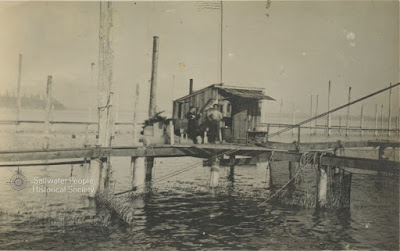 |
Trap watchman's shack . Low res scan of an original photo, pre-1912, from the archives of the Saltwater People Historical Society© |
These were exciting times with men taking big risks to get in on the action. A few of these men who should be mentioned were the fish pirates that wanted to dip into the spiller and dip in they did. Each trap had a watchman who stayed in a little shack right on the trap in most cases. He was to watch out for predators and junk getting fouled in the tunnel. Some of the predators were very tough characters. They didn’t want to hurt anyone, they just wanted some fish. Men like Spider Jones offered bribes of money to watchmen so they would just turn their heads. Some others like “Dirty” Dick, were more threatening, as in bodily harm. Still, others had made their deals with higher-ups in the company and were expected by the watchmen. It was rumored that one of the last-mentioned men went on to be a big processor himself in Alaska in later years.
These were exciting times alright, there were fortunes to be made and fortunes being lost. Everyone had an opportunity to have a job in a great industry. It lasted through the turn of the century, through the “Roaring Twenties” and into the first few years of the “Great Depression.” This was a period of about 45 years. The end came for the fish traps in 1934. By an act of the WA State legislature, the traps were outlawed and could no longer be used. There were several reasons for their actions, but two of them were that the State could not regulate them well enough for conservation. And the purse seiners who had become a big industry themselves complained that the traps were unfair to them because they were taking most of the fish and were a monopoly. Some of the canneries couldn’t survive the loss of the traps, but many others had good fleets of fishing boats and were able to go on."
Above text by John Wade. 4 November 2010.
The Fishermen and the Fisheries of the San Juan Islands with Terry Jackson and Wally Botsford.
The 20 images paired with the text are from the archives of the Saltwater People Historical Society.
* More in-depth history of Pacific American Fisheries can be seen on this State Archives site. Scroll down to "History Note."
The 20 images paired with the text are from the archives of the Saltwater People Historical Society.
* More in-depth history of Pacific American Fisheries can be seen on this State Archives site. Scroll down to "History Note."


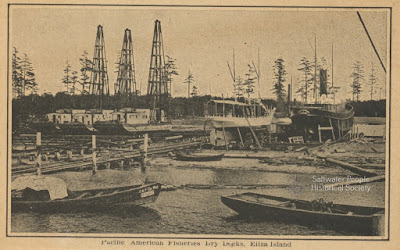
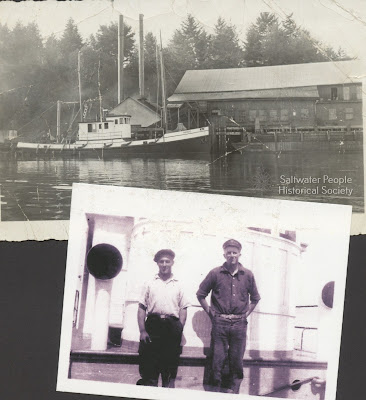



No comments:
Post a Comment